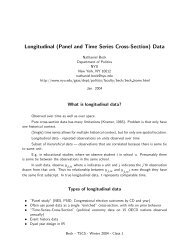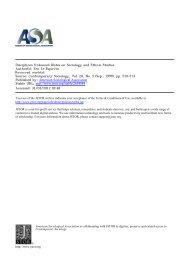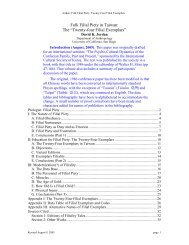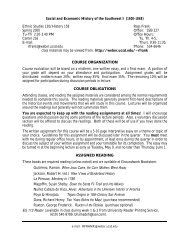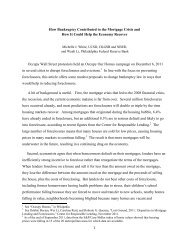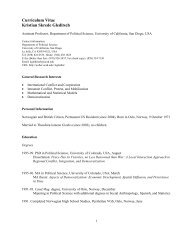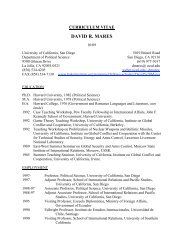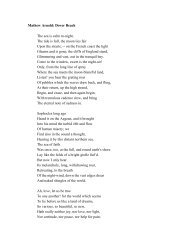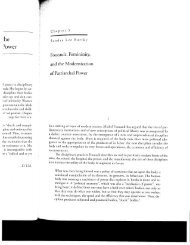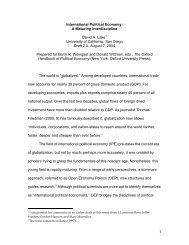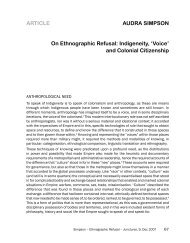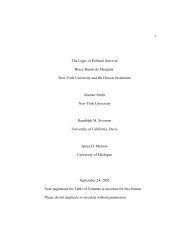Climate change and water resources in the Murray Darling Basin ...
Climate change and water resources in the Murray Darling Basin ...
Climate change and water resources in the Murray Darling Basin ...
You also want an ePaper? Increase the reach of your titles
YUMPU automatically turns print PDFs into web optimized ePapers that Google loves.
ABARE CONFERENCE PAPER 02.11<br />
B1 scenario as <strong>the</strong> reduction <strong>in</strong> <strong>water</strong> availability is smaller than under <strong>the</strong> SRES A1<br />
scenario.<br />
There are, however, significant biophysical outcomes associated with <strong>the</strong> different scenarios<br />
(table 4). These occur for two reasons. First, improved <strong>water</strong> use efficiency leads to a<br />
reduction <strong>in</strong> return flows through reductions <strong>in</strong> surface <strong>water</strong> runoff, ground <strong>water</strong> discharge<br />
<strong>and</strong> dra<strong>in</strong>age that reach <strong>the</strong> river system. This results <strong>in</strong> reduced <strong>water</strong> availability for<br />
downstream users if efficiency is improved <strong>in</strong> areas with relatively low base levels of irrigation<br />
efficiency <strong>and</strong> hence high levels of surface <strong>water</strong> runoff. As consumptive <strong>water</strong> use<br />
from <strong>the</strong> <strong>Murray</strong> River is capped, <strong>the</strong> reduction <strong>in</strong> return flows may generate a cost borne<br />
by downstream <strong>water</strong> users if reduced availability leads to reduced allocations. Flow levels<br />
at different po<strong>in</strong>ts along <strong>the</strong> <strong>Murray</strong> River for improvements <strong>in</strong> efficiency under both SRES<br />
scenarios are shown <strong>in</strong> table 4. Decreases <strong>in</strong> flows occur under both scenarios as crops<br />
transpire a greater proportion of <strong>the</strong> irrigation <strong>water</strong> applied. The <strong>change</strong>s are larger <strong>in</strong><br />
2100 than <strong>in</strong> 2050 because <strong>the</strong> rate of <strong>in</strong>crease <strong>in</strong> <strong>water</strong> use efficiency was aligned to<br />
decl<strong>in</strong>es <strong>in</strong> precipitation.<br />
Second, reduced ground <strong>water</strong> discharge reduces <strong>the</strong> level of salt mobilised <strong>in</strong>to <strong>the</strong> river<br />
system. If efficiency improvements are undertaken <strong>in</strong> areas with highly sal<strong>in</strong>e ground<br />
<strong>water</strong>, <strong>water</strong> quality benefits result<strong>in</strong>g from <strong>the</strong> reduction <strong>in</strong> <strong>the</strong> volume of sal<strong>in</strong>e discharge<br />
to <strong>the</strong> river system may more than offset <strong>the</strong> reduction <strong>in</strong> available surface <strong>water</strong> flows,<br />
generat<strong>in</strong>g downstream benefits. The <strong>water</strong> quality impacts of an improvement <strong>in</strong> <strong>water</strong><br />
use efficiency are shown <strong>in</strong> table 4. Despite <strong>the</strong> reduction <strong>in</strong> flows, reduced leakage <strong>in</strong>to <strong>the</strong><br />
ground <strong>water</strong> system results <strong>in</strong> a much greater proportionate reduction <strong>in</strong> sal<strong>in</strong>e ground<br />
<strong>water</strong> discharge generat<strong>in</strong>g substantial improvements <strong>in</strong> <strong>water</strong> quality. The improvement <strong>in</strong><br />
<strong>water</strong> quality <strong>in</strong> <strong>the</strong> longer term is greatest under <strong>the</strong> SRES A1 scenario as <strong>the</strong> comb<strong>in</strong>ation<br />
Table 4: Changes <strong>in</strong> flows <strong>and</strong> salt concentrations from <strong>the</strong> reference scenario, at selected<br />
locations with adaptation<br />
Water use efficiency Trade<br />
Location Change to 2050 Change to 2100 Change to 2050 Change to 2100<br />
A1 B1 A1 B1 A1 B1 A1 B1<br />
% % % % % % % %<br />
Flows<br />
Murrumbidgee River a –16 –12 –27 –20 –13 –10 –23 –16<br />
Darl<strong>in</strong>g River a –18 –14 –32 –23 –16 –12 –28 –19<br />
Morgan<br />
Sal<strong>in</strong>ity<br />
–18 –14 –33 –24 –16 –12 –28 –19<br />
Murrumbidgee River a –27 –46 –64 –57 –9 –6 –26 –17<br />
Darl<strong>in</strong>g River a –9 –27 –47 –42 1 0 –12 –8<br />
Morgan –7 –31 –48 –45 4 3 –5 –3<br />
a Below <strong>the</strong> confluence of <strong>the</strong> <strong>Murray</strong> River.<br />
27




